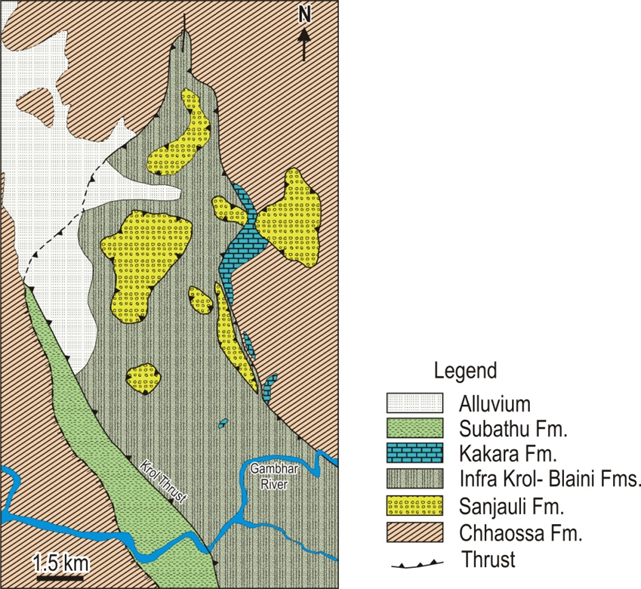Blaini Fm
Type Locality and Naming
Himachal Pradesh-Uttarakhand, Baliana Brook. The genesis of the Blaini Formation has been controversial. Auden (1937) favoured a glacial origin, Krishnaswamy & Swami Nath (1965) opined that the Blaini diamictites are fanglomerates accumulated at the foot-hill of nearby scarps that were transported to the interior parts of the basin by turbidity currents as mudflows. Rupke (1968) and Valdiya (1973) considered them as turbidites. Bhargava & Bhattacharyya (1975) and Jain (1981) interpreted diamictite horizons of the Blaini Formation as glaciomarine deposits. Tangri & Singh (1982) regarded the Blaini Formation as shallow subtidal sediments with input of mudflows. [Original Publication: Ganqing Jiang, Nicholas Christie-Blick, Alan J. Kaufman, Dhiraj M. Banerjee, and Vibhuti Rai, J.B., 2002. Sequence Stratigraphy of the Neoproterozoic Krol Platform. Journal of Sedimentary Research, Vol. 72, No. 4, July, 2002, P. 524–542.]
Synonym: Baliana Gr (Martin 2017); some authors denoted this Fm as Gr.
Lithology and Thickness
Glacial till. Two levels of diamictites, shale, slate, sandstone, dolostone; 30-45 m. Only the uppermost part of the Blaini Fm is shown as the ‘‘cap carbonate’’ (5–15 m thick) is exaggerated. Authors favouring a non-glacial origin of the Blaini based their observations on the bedding features of the Member B, which is an interglacial unit and did not address to un-bedded, structureless diamictites (Members A and C), persistent at the same stratigraphic levels for more than 200 km between Jamrot and Lansdowne. Bhargava & Bhattacharyya (1975) summed up various evidences and concluded a glaciomarine genesis for the Blaini Formation,a view which has been widely accepted (Brookfield 1987).
[Figure: Lithostratigraphy (provided by O.N Bhargava & Birendra Singh)]
[Figure: part of Himachal Pradesh geologic map showing relationships among Chhaossa Fm, Sanjauli Fm, InfraKrol Fm, Blaini Fm, Kakara Fm and Subathu Fm (provided by O.N. Bhargava & Birendra Singh)]
Relationships and Distribution
Lower contact
Unconformable with Basantpur Fm, Chhaossa Fm, Sanjauli Fm, Nagthat Fm.
Upper contact
Conformable with InfraKrol Fm, unconformable with Subathu Fm / Kakara Fm
Regional extent
Himachal Pradesh and Uttarakhand. The Blaini Formation is exposed between Jamrot (north of the Gambhar) and Nepal (?). It has a greenish-grey clayey matrix up to Lansdowne Syncline (Uttrakhand). In the Nainital area and further east in Nepal (?), the matrix is arenaceous and locally has reddish tinge. In the west, the Tannaki diamictites have similar stratigraphic level and bear a close resemblance to the Blaini diamictites. In the Higher Himalaya its possible equivalent is the Manjir Formation, which lacks cap carbonate.
GeoJSON
Fossils
Stromatolites
Age
Depositional setting
Glaciomarine
Additional Information
Also considered mud flow and turbidites. See Bhargava et al., 2021. Evolution of the Lesser Himalaya in space and time. Himalayan Geology, Vol. 42 (2), 2021, pp. 263-289.

